SDC is the large scale application of the Starship to lunar colonization. The use of "One Way" Starships will be extensive. This in enabled by the low cost of Starship "bodies" ($50M total cost to orbit estimated). To this the cargo area can either carry a nearly 9m wide payload up to 100 tons ... or it can be build out to act as human habitats and other pressurized facilities. See some great links here for lunar exportation information. We are not the only ones excited about the possibilities of SC, check out this link.
SDC emphasizes large modules that are ready to automatically deploy and operate as soon as they are on the lunar surface. This allows for complete fabrication and testing in the comfort and cost efficiency of a normal environment. The goal is to minimize the need for humans to perform construction and maintenance in the Lunar vacuum. That time is better spent in productive activities or even simple tourism.
But let's not underestimate the challenge ... in terms of fuel needed to move mass to and from the Moon, the Moon is more expensive than Mars as you can aerobrake at Mars, and you can't do that on the airless Moon. While the SpaceX Starship system is by far the most powerful and cost effective option some strategies are needed that are not needed at Mars.
1) Most un-manned missions will be "One Way" and expendable. These use the Cargo Starship body with landing legs, no TPS, no Flaps or Fins or Cargo Bay. Either an expendable fairing or a nosecone-on-cylindrical-payload is used at launch and dropped off just after Starship clears the atmosphere. Fortunately at vehicle cost of $50M and a LEO refuel cost of $50M we can bring cargo, equipment and ready to use large finished structures to SC at $100M for 100+ tons. The term OWLS (One-Way Lunar Surface) Starship denotes a Starship with broad landing legs that can bring 100 tons of payload/cargo at $1M/ton (all cost included) to the SCR.
The earliest need will to establish Power, Communications, Sensors and Navigation (PCSN) services for operations in and around SC. Our proposal is to outfit a number of Expendable Cargo Starships with PCSN hardward and place them around the top edge of SC, which is in the sun 95% of the time, and has a stable clear Line-Of-Sight back to Earth. A Power Beamer can then wirelessly send power anywhere into the darkness of the SC ergion. Receivers on habs, rovers, machines receive this power on a rotating schedule and buffer them into batteries. The project starts with one ($500M each, delivered), then adds 2 more ASAP at points spaced on the SN rim to create a cm accurate navigation service in SC and around parts of the SDR. More info here,
As the facility exceeds the ability of 3 PCSN towers to power ... additional PCSN towers could be deployed, or large PV blankets on the ridge connected by long power lines to the facility (which would produce power 1/2 the 28 Earthday Lunardays).
Also, on that first PCSN mission, the tower will drop a number of inflatable rovers that will roll down into the SCR.
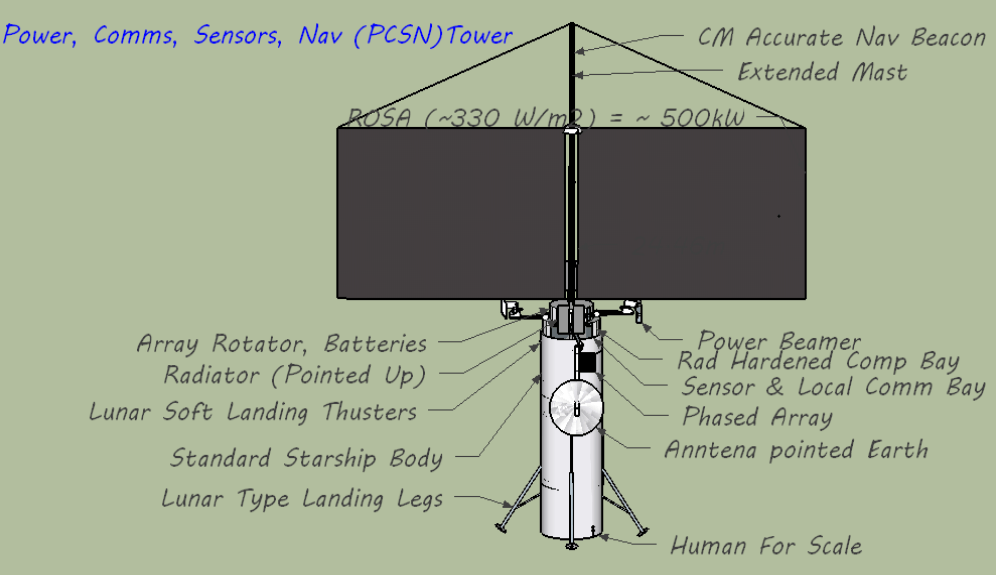
PCSN Tower
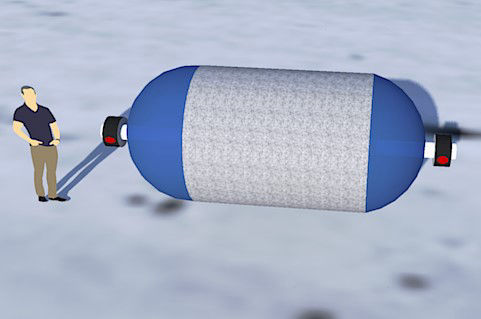
Inflatable Rover
These rovers ($50K each) are carried to the lunar surface as part of PCSN Tower cargo as 4 meter long 0.8 meter wide cylinders. They are deployed by first inflating to a 3 meter width and then dropping in the 1/6 gravity 25 m to the lunar surface. They then bounce and roll down slope to a stop. Fully charged to start, they communicate via the PCSN tower to operators on Earth that can then drive the rover in with only a 4-5 second lag. The PCSN tower can illuminate the rovers with it's power beamer as needed so that can operate in the darkness of SC indefinitely (or in other areas of the SCR when dark. The rovers complement the Sensors on by operating with the Navigation service to find the best location to site habs, machines, landing facilities and lunar resources (most critically ice). Each rover has two multi-spectral HD cams and lights with mm resolution of soil beneath the rover. They also have beacons to aid in positioning and navigation. The goal is to find a 1 km square that balances light (Earth-shine +solar dark/dim), flatness, effective temperature, surface hardness, radiation risk, and proximity to potential water rich lunar soil.
A standard HLS Starship ($300M Mission Price) will launch with a Crew from Earth to LEO. In LEO it will be 100% re-fueled at the LWO fuel depot. It will then leave LEO and land directly in the SDR with help of the PCSN's Navigation aid and beacons in the rovers at an optimal place at the SCR. SDC personal will conduct surface operations with the aid of crew rover and collect samples from rover located points, and set out additional sensor and test equipment and navigation beacons. The focus will be on finding "hard" landing sites and deposits of ice bearing lunar soil. The PCSN will beam power to Crew Starship Starship during the entire mission. After a few weeks the crew will take HLS Starship up to Low Lunar Orbit and rendezvous with a Crew Starship. Crew and cargo will be exchanges. Crew Starship returns to Earth. A Cargo Starship docks with HLS Starship and transfers about 200-250 mT of fuel to allow for another HLS Starship round trip to the Lunar surface and back to LLO. The Cargo Starship return to Earth.
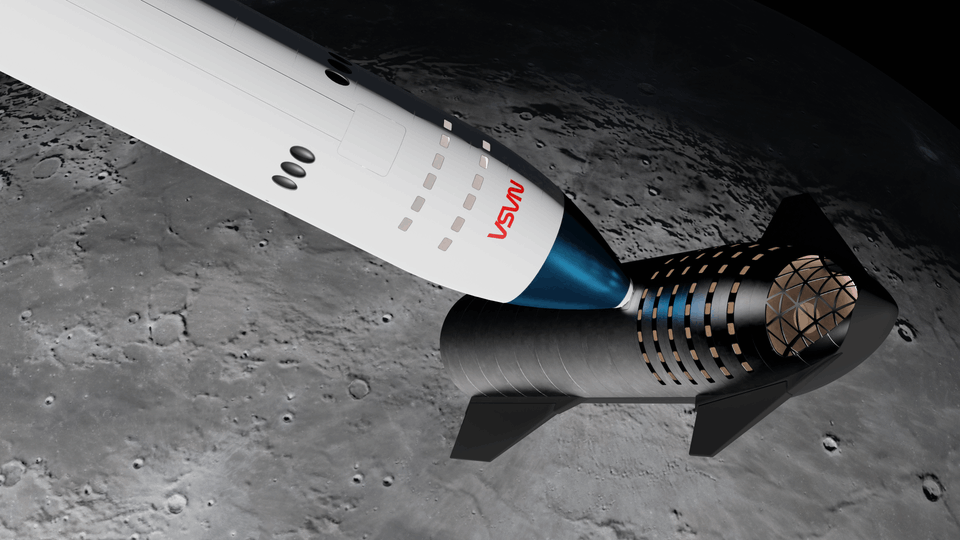
Crew Starship Lunar missions meet up the HLS Starship to transfer up to 40 mT of crew and cargo (this is not my render). HLS Starship will also need about 200-250 mT of fuel to land and return to Low Lunar Orbit ... this can be brought by a 100% refueled in LEO Cargo Starship (not shown) ... that can then return to Earth.
We purchase the body of an Cargo Starship with landing legs and soft landing thrusters, no TPS and no flaps and no nosecone from SpaceX for $100M ... let's call it OWLS (One Way Lunar Surface). We also contracted to create a 10 ton "Lunar Pallet" that is attached to the top of OWLS. On top of that we place a 100 ton Lunar Habitat ($1B) that we have had built. The lunar habitat is capped with an nose cone for launch that is ejected at LEO. Our OWLS rendezvous with the LEO Fuel Depot (see render below) and and fuels up with enough fuel for a one way trip with 110 ton total payload ($100M). The combination departs and after 3 days arrives at the landing point mission 2 designated. With a combination of Raptor burns and cold gas thrusts from the Lunar Pallet we softly set down. Finally the Lunar Pallet with the Habitation Module payload on top disconnects from OWLS and fires it's SuperDrago engines to lift about 1 m off the top as the cold gas thrusters push the pallet and payload sideways 50m ... then softly land the pallet and payload. OWLS and Lunar Pallet are now done. The Lunar Habitat (Lunar HQ) connects up the the PCSN tower and begins long term checkouts with the first long term crew gets ready for Mission 4. The bottom 1/2 of Lunar HQ is stuffed with flexible lunar tunnels, an automated tunnel rover (accessible from a large rear hatch - not shown) and a water mining rover.
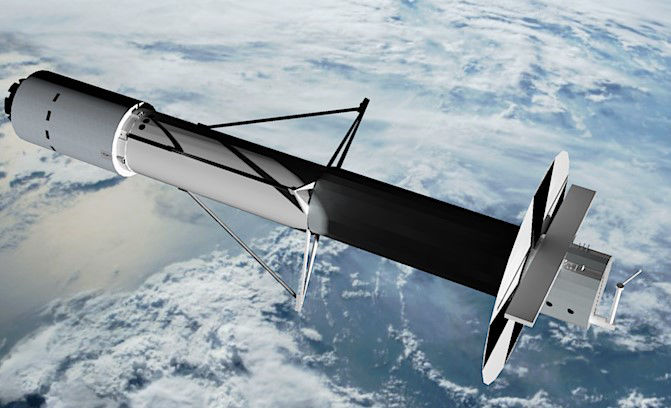
HQ Module on OWLS in LEO being 100% refueled at an unmanned orbital depot
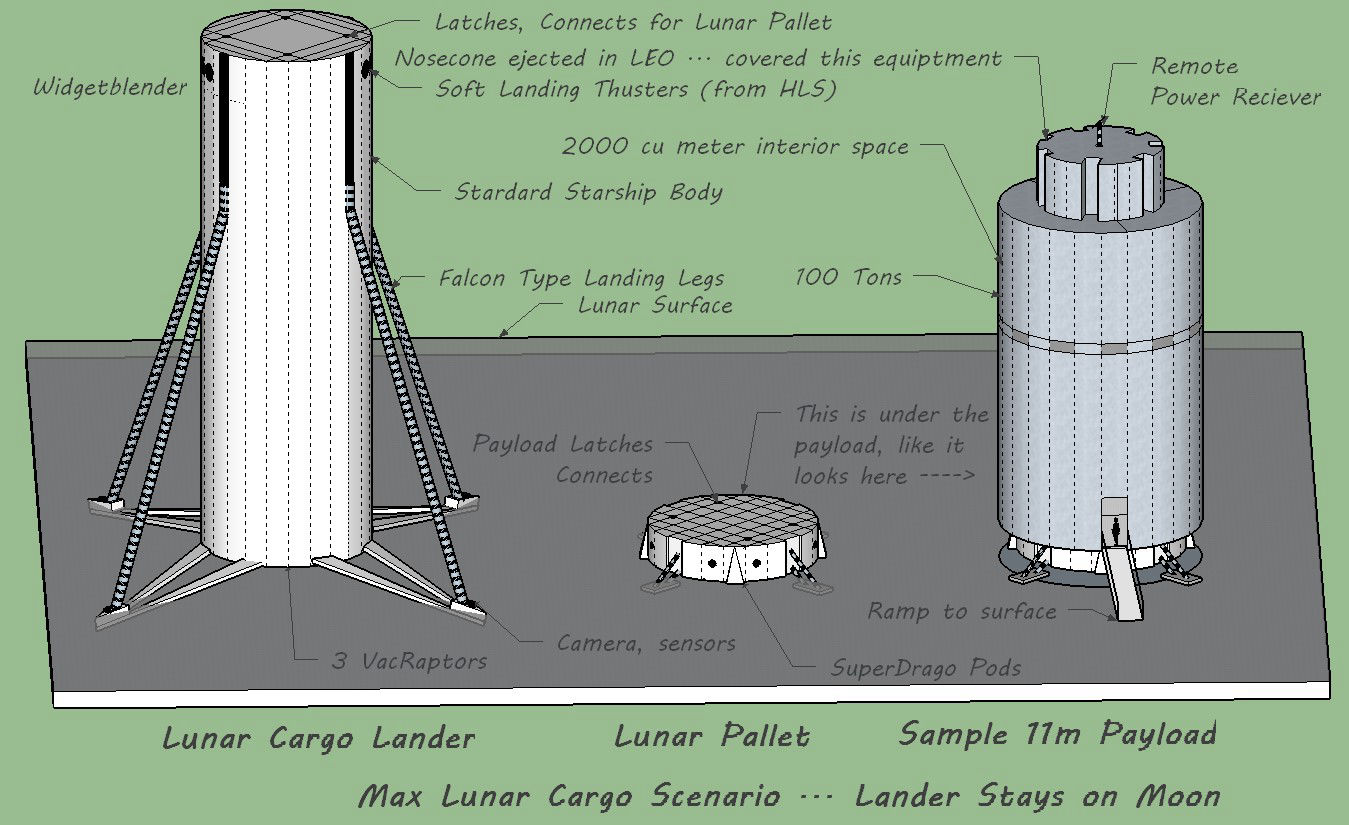
SpaceX Starship based OWLS (One Way Lunar Surface) Cargo System
Job #1 will be to search for lunar soil that contains water ice. Water ice is key to a lunar colony of any scale. It is needed for local production of water, O2 combined with N2 (from Earth) for Air, O2 for LOX to partly refuel Starships for Earth (greatly increasing payloads) return and LOX and LH2 for local vehicles. More info here and here. Bringing water from Earth might cost as little as $1M/ton. If (as some research suggests) 1 ton of lunar soil (in perma-shadow) may contain 1 kg of water, 100,000 tons of soil must be processes to get the equivalent. At $10/ton for water processing we get to the same amount of water for the same price. Only water finds and production experience will indicate if water production in the SCR will be more cost effective than bringing it from Earth. O2 from lunar soil is also a possibility (see bottom of page)
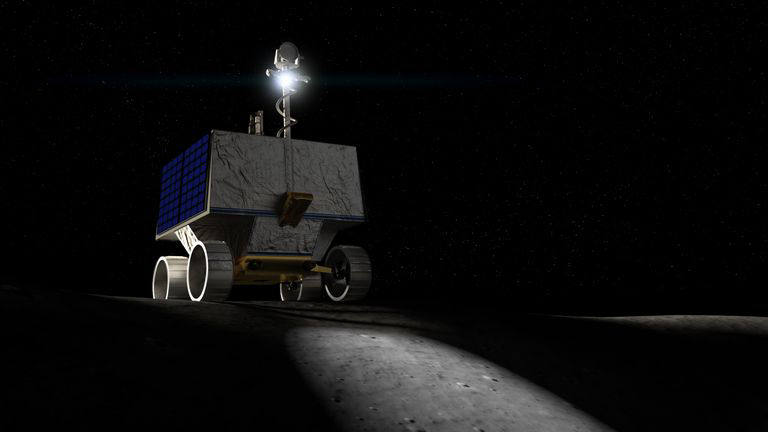
Viper water searching rover, image credit: NASA Ames
Another way to get around the "that first step is a doosy" issue with HLS Starship for a habitat is to simply land a One Way Starship without legs, fins ... vertically, then softly drop it on it's side by using node thrusters to pivot it from vertical to horizontal. Once horizontal, it deploys the Beamed Power Receiver and connects to the power and comms of the PCSN tower. The 2 Meter Airlock will be connected to the flexible tunnel system to connect to other structures. This structure also leverages the Crew Starship life support technology. Later empty fuel tanks can be converted to pressurized space for $1M each ... or can be used to store H2O (with heaters, LH2, Liquid C02, Liquid Nitrogen or other liquids and gases. In this case the Mission Defined Area has water-from-lunar-soil extractor machinery for testing. The machine also has a connector, which is opened after LOX venting, that allows collected water to be stored.
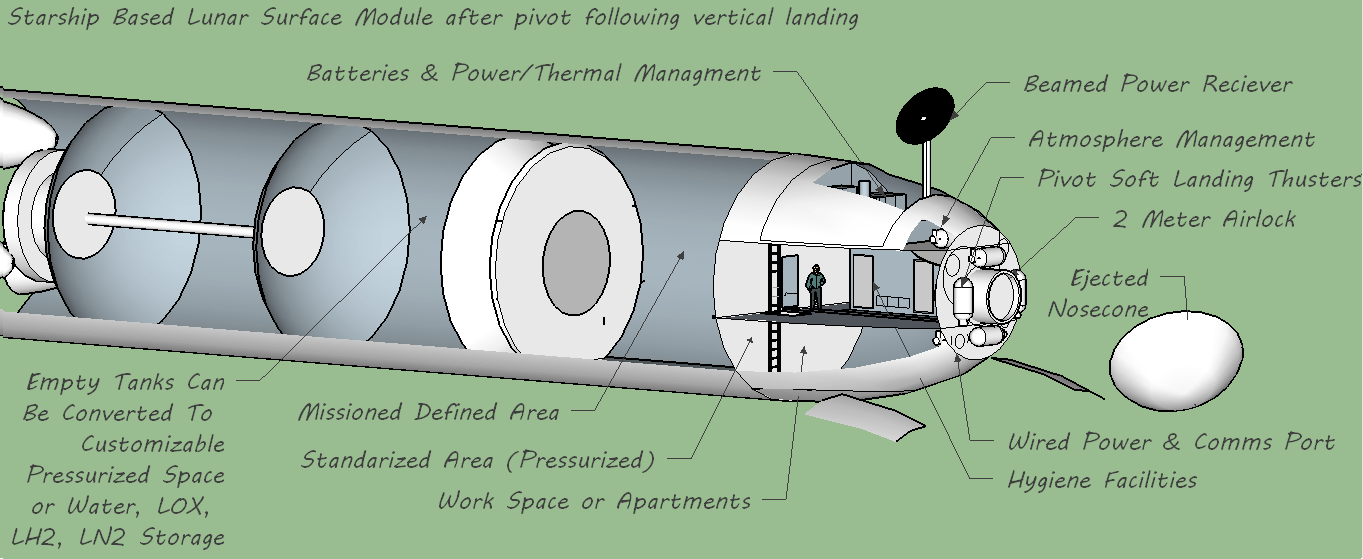
A "pivot" module after a soft pivot.
While some tunnel components arrived earlier, mission 6 brings 100+ tons of it and additional support equipment. The first Pivot Module, HQ are connected.
Mission 7 uses OWLS to land a payload that is a pressurized pair of "gates" that can extend to create a pressure dock to a Crew Starship. The payload also has a crane that carries a elevator that can extend 20 m out and can extend to the surface. After the fuel if full vented the base construction crew cuts and welds to attach the tunnel adapter and ramp to the bottom fuel tank. They then ride the elevator to get access to the top, proceed inside and then cut cut and weld into the tank bulkheads to create a space for an elevator to be added.
Cargo mission 8 brings material for hard landing pads ... which are assembled next to the gantry. At also brings film and frames (shown as gold below) to construct engine blast deflectors, which are erected. Mission 9 brings the first standard Crew Starship with minimal landing legs, and additional crew. This Crew Starship has been refueled in LLO by a Cargo Starship so that it can return directly to Earth. This ship will remain as a "lifeboat" until another Crew Starship arrives.
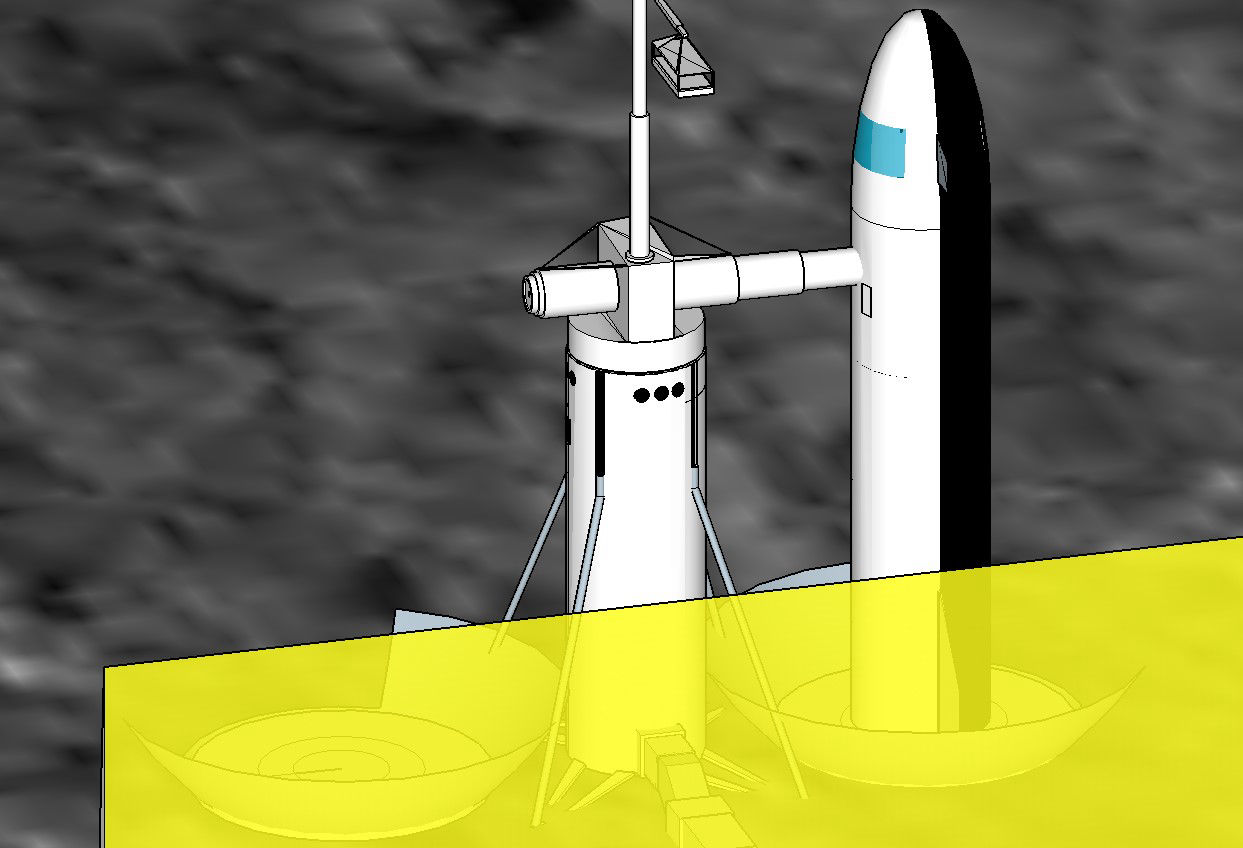
Launch Gantry Complex in action in Mission 9
Later the use of inflatable structures that can be delivered on a single Cargo Starship and deployed with a crane ... or with a Lunar Pallet ... is begun ... to create a garden in the desert of the SCR. Note that there is a 2.5 m high 8m wide cylinder at the bottom that contain the hatches and the machinery. At the center of the dome is a circle of clear fabric to watch the stars. Some rigid (grey) walkways allow for congregation space. A stream of tricking water complete with Earth rocks remind the visitors of home.
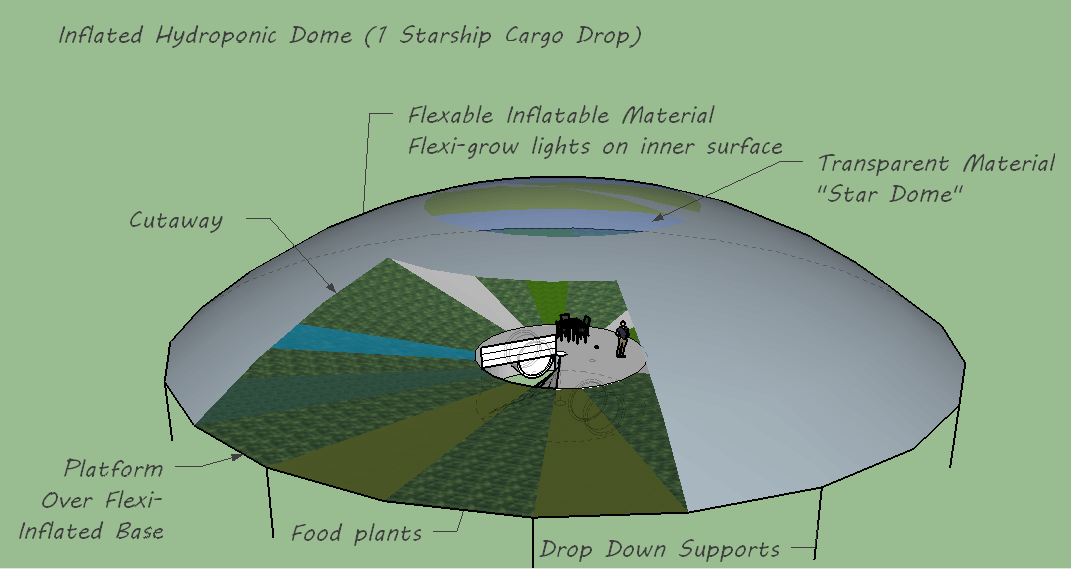
Inflated Hydroponic Dome delivered on a 8m Lunar Pallet ($30M total transport cost)
The following is a depiction of the base after several years of delivery and integration. Two empty OWLS stand outside the base after dropping off the HQ and Dome payloads. The Pivot Modules have been soft landed and joined to the tunnel. Dust deflectors have been added between these and the landing facility. The gantry tower services two hard landing pads that eliminate the need for large landing legs. This depicts a Crew Starship landed and connected to the gantry. Overall pressurized living/work space is approximately 20,000 cubic meters. Population is approximately 100. Several OWLS are also off screen, each having delivered 100+ ton supply payloads. 3 PCSN towers at the crater rim are feeding power to the complex and power lines may have been laid from them to the facility at this point. The base is ready for tourism.
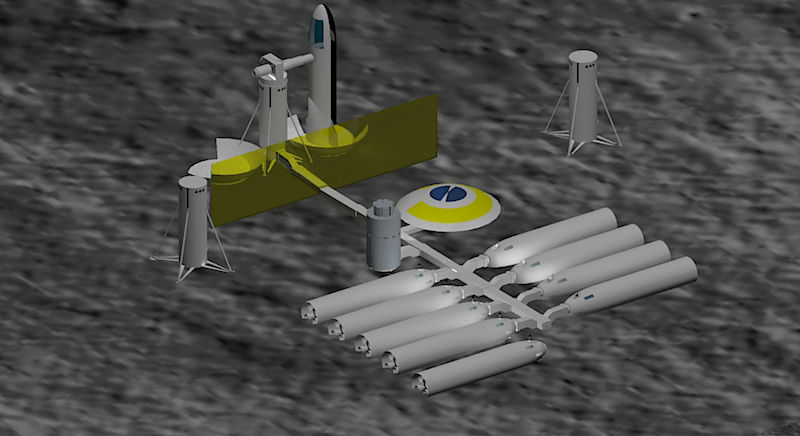
Shackleton Base after approximately 20 missions (new Pivot Module has not yet been connected to the tunnels)
The enthalpy of formation of silicon dioxide is about 4 times that of water, but SI02 has twice the oxygen of water. But the moon is not made of silicon dioxide. It is a complicated mix of metal oxides, silicon oxides, nanophase iron, and other species.
So in general, yes, it takes more energy to make oxygen from regolith than it would from water, but finding and mining the water will probably take a lot of energy. For oxygen from regolith, all the material you need will be right beneath you, no matter where you land. No searching or refining required.
Lunar LOX would be a boost to the effort ... I did not see how they could gather enough H2O to make it work. But Solar LOX from regolith might work. Per the 1 Starship solar power plant (4MWh/Earthday Solar power plant on Mars should be 8MWh/Earthday at the Lunar Equator). So good power 1/2 the time, but the following process looks a bit tricky to work at scale:
"The processing was performed using a method called molten salt electrolysis. This is the first example of direct powder-to-powder processing of solid lunar regolith simulant that can extract virtually all the oxygen," Lomax explained.
So ....
Very low mining costs
High energy needs (one might just use solar concentrators for direct heating) ? Does it lend itself to mainly continuous flow production, like Mars Methane and LOX?
To be part of fuel program it would seem maybe 1 mT of production a day would be needed ...
In addition you might want Starship's with Extended Liquid Methane Tanks ... I think Elon did mention this.
Of course the more a Starship fuel run to the LEO costs (with all long term costs factored in) ... the more that this matters. At some point Lunar LOX to C3 might make economic sense.
Looks like some searching to get more specifics to see if one could size a 1 mT/Earthday LOX production capability.
Research Links:
https://www.sciencealert.com/scientists-have-figured-out-how-to-extract-oxygen-from-moon-dirt
https://www.esa.int/Enabling_Support/Space_Engineering_Technology/ESA_opens_oxygen_plant_making_air_out_of_moondust
https://metalysis.com/metalysis-awarded-european-space-agency-development-contract-for-its-ffc-process/
https://www.google.com/search?q=lunar+oxygen+production+images
Mobirise free website software